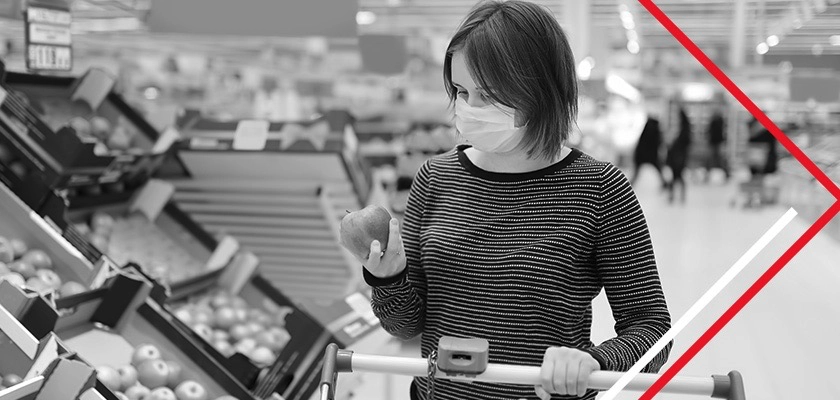"The Family and COVID-19: What Can We Say So Far?" - Andrew J. Cherlin, Ph.D. | September 2020
Sociologists are studying how the pandemic has affected families. From early reports and comparisons with the past, we can draw some conclusions.
Griswold Professor of Sociology and Public Policy
Johns Hopkins University
Author of Public and Private Families, McGraw Hill

The COVID-19 crisis hit families hard. At the same time, it demonstrated how important families still are. Laid-off workers relied on support from their families to get by. College students, their campuses shuttered, lived with their parents, and tried to learn at a distance. Young children looked to their parents for help with online schooling. Families have always been a source of comfort and support during tough times, and the coronavirus pandemic was no exception.
Yet the crisis proved perilous for many families. A case of COVID-19 threatens not only the individuals who catch it but also the family members with whom they live. If parents lose jobs due to the crisis, their families may face eviction. Family members living in crowded quarters risk spreading the deadly disease. Workers who are more likely to do essential but dangerous jobs, such as stocking grocery shelves or keeping hospitals clean, risk bringing the virus home to their loved ones. Parents have to juggle supervising their children’s online education with working online themselves.
Members of Black and Hispanic families experienced higher rates of COVID-related disease and death than did non-Hispanic whites (U.S. National Center for Health Statistics, 2020), perhaps because of a lack of health insurance, or because of long-standing health inequities and discrimination, or greater exposure due to essential jobs.
Social scientists are just beginning to study how the pandemic has affected families. But from early reports and from comparisons with past health and economic crises, we can draw some tentative conclusions.
The slowing of the family life course.
You might think that job losses, illnesses, and deaths would lead to so much tension in marriages that the divorce rate would rise. Yet even if there has been a rise in family conflict, it’s likely that divorce rates will go down during the crisis rather than up. That’s what happened during the Great Depression of the 1930s. The divorce rate plunged by 24 percent between 1929 and 1932 (Cherlin, Cumberworth, Morgan, & Wimer, 2013). Yet no one thinks that couples remained together during the Depression because they were happier. Rather, it was too expensive and difficult to get a divorce.
A separation meant paying for two places to live. It also meant that parents and adolescents could no longer pool their earnings into one pot, which was often necessary in order to subsist. Today, add in the fear that entering new spaces will expose a person to the coronavirus, and you may understand why breaking up a family and leaving home may feel unsafe during a crisis-- even to those who, in calmer times, would have divorced.
In fact, every demographic rate fell during the Great Depression. In addition to the decrease in divorce, single people postponed getting married and married couples postponed having children. The pace of people’s family lives-- the speed at which they formed partnerships, had children, and dissolved their partnerships-- slowed.
The same pattern occurred during the 1918 influenza epidemic, which killed hundreds of thousands of Americans: Spikes in death rates led to declined births nine months later (Aassve, Cavalli, Mencarini, Plach, & Bacci, 2020). A similar slowdown seems to be happening during the COVID-19 crisis: A national survey in 2020 found that, because of the pandemic, more than one in three women wanted to delay having a child or to limit future births (Lindberg, VandeVusse, Mueller, & Kirstein, 2020). The family life course is slowing again.
Still, these demographic declines could be temporary. In the mid-1930s, the divorce rate began to rise as the country climbed out of the Great Depression, and there was no decline in the lifetime chances of divorce for adults who experienced the Depression (Cherlin et al., 2013). In all economic recessions since the Great Depression, the effects on fertility have largely been limited to postponing having children-- perhaps waiting a couple of years-- rather than not having children at all (Sobotka, Skirbekk, & Philipov, 2011). How much the COVID-19 crisis delays family events versus how much it permanently cancels them remains to be seen.
Gender inequality in the division of labor.
Yet the effects of the pandemic go well beyond demographics. The closures of workplaces and schools altered the daily lives of parents as they struggled to meet the demands of working from home while their children were also home taking online classes. A pre-COVID-19 study showed that on days when fathers worked from home online-- sometimes called telecommuting-- they spent substantially more time caring for their children than on days when they worked in an office, but they didn’t do more housework on the days that they worked from home. Rather, telecommuting mothers increased the amount of time they spent on housework (Lyttelton, Zang, & Musick, 2020).
Childcare may be intrinsically rewarding for parents, and therefore a task that fathers will take on. But cleaning the home usually isn’t as rewarding, and fathers seem reluctant to do more of it. Mothers also spent more time with their children while they were working (or trying to work) than did fathers. That fathers are doing more childcare helps working mothers; that they aren’t doing more housework adds to working mothers’ burdens.
Moreover, during the early months of the crisis in 2020, mothers reported leaving the workforce and reducing their work hours at a higher rate than fathers, according to one study (Landivar, Ruppanner, Scarborough, & Collins, 2020). Another study compared working mothers in states in which schools closed early in the crisis (before mid-March, 2020) with working mothers in states in which schools closed later (in late March or April, or May). The idea behind the study is that parents had to make a quicker, and therefore more difficult, adjustment to the pandemic in the early-closing states.
Indeed, mothers in the early closing states were more likely to take a temporary leave from work than were mothers in later-closing states. Fathers, however, did not change their work behavior much, regardless of when schools in their states closed (Heggeness, 2020). These findings suggest that mothers bore the responsibility of adjusting to quick school closings by taking a leave from work, whereas fathers did not take on more responsibility by leaving work.
Overall, then, with the notable exception of who’s doing the childcare, the COVID-19 crisis seems to be disadvantaging mothers compared to fathers and therefore increasing gender inequality. Still, it’s possible that the crisis will also lead to greater support in the future for childcare programs for working parents. As part of its massive virus-relief legislation, Congress passed the Families First Coronavirus Response Act. It provided many, though not all, employees with up to 12 weeks of expanded family and medical leave at two-thirds of the employee’s rate of pay.
The Democratic nominee for President, Joe Biden, issued a proposal in July of 2020 for universal preschool for three- and four-year-olds plus other childcare assistance. By demonstrating the difficulties that parents-- and especially mothers-- face in combining domestic work with market work, the pandemic could possibly lead to national preschools or more generous childcare subsidies.
Domestic Violence.
Even if the COVID-19 crisis isn’t leading to an increase in divorce, it could lead to an increase in violence against intimate partners and to more child abuse. Indeed, the necessity of staying together could create a pressure-cooker effect, in which partners who are prone to violence and abuse would be driven to it by the tensions of unemployment and disease. Much of the increase could go unseen until the lid is lifted-- which in this case may not occur until social distancing is no longer necessary and people can freely leave home.
Although calls and texts to intimate partner violence hotlines have increased in some cities, they have decreased in others (Bosman, 2020); and documented cases of child abuse have dropped sharply (Stewart, 2020). The drop in reported child abuse could be considered good news; but child service providers are concerned that without reports from the outsiders who ordinarily see children, such as school teachers and nurses, injuries to children may be going unreported and untreated (U.S. Substance Abuse and Mental Health Services Administration, 2020). We may need to wait until schools, shelters, clinics, and physicians’ offices are fully open to learning whether there have been increases or decreases in violence against intimate partners and children.
* * *
This is only an interim report. It was written a half-year into a health and economic crisis that will last for several more months or possibly several years.
Many questions remain unanswered. For instance, will we see lasting changes in what mothers and fathers do at home and in the assistance they receive for childcare? Will telecommuting permanently replace a large share of jobs that used to require a real commute? Will the shift to online schooling result in lower academic achievement for children and adolescents?
We cannot be certain of the long-term effects. We can be certain, however, that COVID-19 will continue to challenge the capacities of family members to care for and support each other during a period in which we need strong families as much as ever.
Questions for Discussion
- If COVID-19 slows down the family life course for young adults, would that be a bad thing or a good thing? What other potential impacts could this have?
- Why would women’s daily lives be affected more than men’s daily lives by the COVID-19 shutdowns and restrictions?
- Why might COVID-19 increase intimate partner violence and child abuse in the home?



